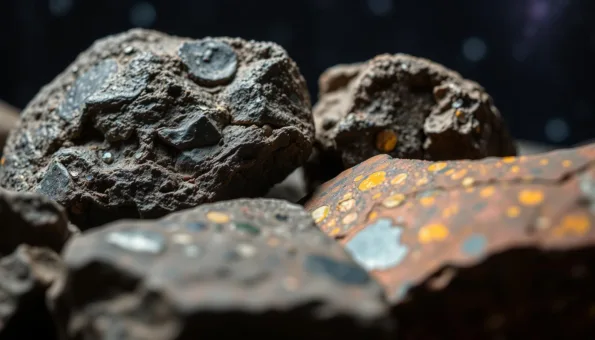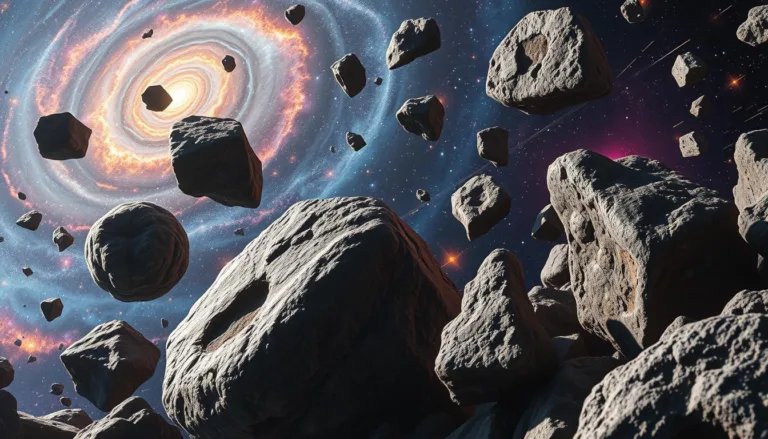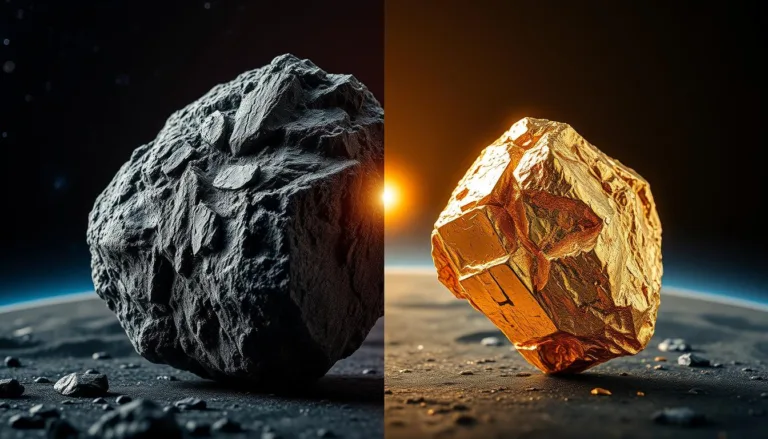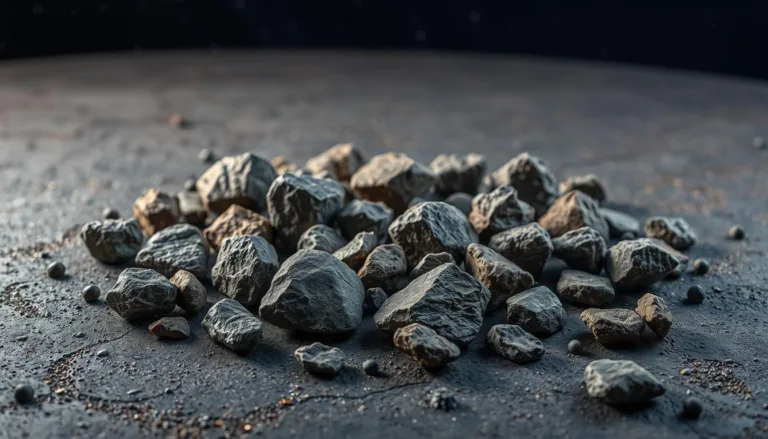Exploring our solar system, we find a treasure trove of wonders – meteorites. These rocks come from asteroids and comets. They have fascinated scientists and collectors for centuries.
Some meteorites are common, but others are very rare. These rare ones hold secrets of our universe.
Meteorites act like time capsules, showing us the early days of our solar system. They give us a peek into the past. By studying these rare rocks, we learn more about our galaxy and beyond.
Key Takeaways
- Meteorites are fragments of asteroids and comets that have made their way to Earth.
- The rarest meteorites are the most valuable and scientifically significant, offering a window into the early solar system.
- Studying these celestial treasures can reveal crucial insights about the formation and evolution of our universe.
- Meteorite collectors and scientists alike are fascinated by the mystery and value of these extraterrestrial rocks.
- Understanding the rarity and uniqueness of certain meteorites is crucial for appreciating their scientific and cultural significance.
The Fascinating World of Meteorites: From Space to Earth
Meteorites are pieces of space that land on Earth. They tell us about the universe. These cosmic remnants come from stars and planets, giving us a peek into our solar system’s past.
Understanding Meteorite Classification
Meteorites are divided into three main types. Each type is based on what they’re made of and where they come from.
- Stony meteorites, the most common, are mostly made of silicate minerals.
- Iron meteorites, dense and metal-rich, are thought to be from destroyed planets or asteroids.
- Stony-iron meteorites, a mix of both, have elements from stony and iron meteorites.
The Journey from Asteroid to Earth
Meteorites come from asteroids that break apart in space. They travel for thousands of years, sometimes hitting Earth. When they do, their outer layers may burn off, leaving a fusion crust.
How Scientists Identify Authentic Meteorites
Finding real meteorites can be tricky. Scientists use many methods to check if they’re genuine. They look at the meteorite’s minerals, isotopes, and physical signs like fusion crusts and regmaglypts.
| Meteorite Type | Composition | Distinguishing Features |
|---|---|---|
| Stony Meteorite | Silicate Minerals | Fusion Crust, Regmaglypts |
| Iron Meteorite | Metallic Iron | Distinctive Texture, Lack of Fusion Crust |
| Stony-Iron Meteorite | Silicates and Metals | Hybrid Composition |
By studying these space rocks, scientists learn more about our solar system and life on Earth.
What Are the Rarest Meteorites: A Comprehensive Guide
In the world of meteorites, some are truly rare. Chondrites, iron meteorites, and stony-iron meteorites are among the most sought-after. They give us a peek into how our solar system formed and evolved.
Chondrites are some of the oldest objects in our universe. They date back to the solar system’s birth. These meteorites are made of small, round particles called chondrules. They offer insights into the early days of planet formation.
Iron meteorites are rare but highly valued. They come from the cores of asteroids that no longer exist. Their unique makeup and patterns make them interesting to scientists and collectors.
Stony-iron meteorites are a rare mix of minerals and metal. They give us a look into the mysterious processes inside asteroids. Their unique look and scientific value make them highly sought after.
Each type of meteorite holds secrets of our solar system’s past. From ancient chondrites to the mysterious iron and stony-iron types, they amaze and inspire. As we explore the cosmos, these rare meteorites are among the most valuable treasures on Earth.
Lunar and Martian Meteorites: Celestial Treasures
The world of extraterrestrial rocks and alien minerals is fascinating. Lunar and Martian meteorites are among the rarest and most sought-after. They give us a glimpse into the Moon and Mars’ geological past.
Unique Properties of Moon Rocks
Lunar meteorites come from the Moon’s surface. They have special mineral compositions and textures. These features help scientists understand the Moon’s history and how it formed.
Identifying Authentic Martian Specimens
Finding Martian meteorites is rare, with only a few dozen confirmed. To spot these, scientists use detailed analysis and special techniques. This helps prove if a rock is from Mars.
Scientific Value and Research Impact
Lunar and Martian meteorites are incredibly valuable. They help us learn about the solar system’s formation and evolution. These rocks have greatly influenced astronomy and planetary science.

“Lunar and Martian meteorites are like time capsules, preserving invaluable insights into the distant past of our solar system.”
As we study these extraordinary rocks, scientists look forward to new discoveries. These will help us understand the universe and our place in it.
Pallasite Meteorites: Nature’s Space Gems
In the vast universe, pallasite meteorites stand out as rare and captivating. They are the result of ancient collisions between planets. These gems show us the ever-changing nature of our universe.
Pallasite meteorites mix olivine crystals with nickel-iron alloy. This mix comes from deep within a protoplanet. They display vibrant colors, from green olivine to silver nickel-iron, captivating scientists and collectors.
These meteorites are very rare, making up less than 1% of all found meteorites. Their rarity makes them highly sought after. The most valuable ones can sell for high prices in the meteorite market.
| Pallasite Meteorite Characteristics | Significance |
|---|---|
| Unique Olivine-Nickel Iron Composition | Provides insights into the differentiation and layering processes within protoplanets |
| Stunning Visual Appearance | Captivates both scientists and collectors with their natural beauty |
| Exceptional Rarity | Accounting for less than 1% of all known meteorite finds, making them highly coveted |
Exploring space debris and cosmic remnants is fascinating. Pallasite meteorites are a key part of this exploration. They help us understand our universe’s past and inspire us to learn more about our celestial home.
“Pallasite meteorites are a true work of art, forged in the crucible of the cosmos and gifted to us as a window into the past.”
Historic Meteorite Discoveries That Changed Science
Throughout history, the discovery of remarkable astromaterials from space has changed our understanding of the universe. These interstellar fragments, known as meteorites, have given us valuable insights. They have revolutionized modern astronomy and geology.
Famous Finds Throughout History
The Willamette Meteorite, found in Oregon in 1902, is a famous discovery. It weighs over 15 tons, making it the sixth-largest meteorite found on Earth. It is believed to have come from the asteroid belt, giving us a rare look into our solar system’s formation.
Impact on Modern Astronomy
The study of meteorites has greatly helped us understand celestial bodies. For example, studying lunar meteorites has helped scientists learn about the Moon’s history and structure.
Notable Museum Collections
- The Smithsonian National Museum of Natural History in Washington, D.C., has a vast meteorite collection. It showcases over 30,000 specimens from around the world.
- The American Museum of Natural History in New York City displays rare meteorite samples. It includes the iconic Willamette Meteorite.
- The Field Museum in Chicago has a remarkable collection of meteorites. It includes the famous Murchison meteorite, which has given us insights into our solar system’s early formation.
These historic meteorite discoveries continue to amaze scientists and the public. They reveal the extraordinary secrets of our celestial realm.

The Market Value of Rare Meteorites
Rare alien minerals and extraterrestrial rocks fascinate both collectors and scientists. A lively market exists for these rare meteorites. Their value depends on several factors, like how rare they are and their scientific importance.
The trade in meteorites has grown, with auction houses and dealers setting prices. Exceptional finds, like the Willamette Meteorite, have sold for millions. Yet, the ethics of collecting and selling these cosmic items are still debated.
Several things affect the value of rare meteorites:
- Rarity and uniqueness of the specimen
- Scientific significance and research potential
- Provenance and documented history
- Condition and preservation of the meteorite
- Demand from private collectors and institutions
As scientists learn more about our solar system from extraterrestrial rocks, their value will likely stay high. It’s important to protect and care for these cosmic wonders. We must find a balance between science, conservation, and the meteorite market.
“The rarest meteorites are like windows into the formation of our solar system, and their value transcends mere monetary worth.”
Conclusion
We’ve explored the amazing world of rare meteorites. These cosmic treasures tell incredible stories. They give us a peek into our solar system’s beginnings.
From lunar and Martian meteorites to stunning pallasite meteorites, they amaze us all. These space rocks have captured the hearts of scientists and fans.
Studying these extraterrestrial rocks opens up new discoveries. They help us learn more about the universe. These rare finds are key to advancing science and sparking our curiosity.
Historic meteorite finds have changed how we see the stars. Their value shows how much collectors love them. These space gems have become a big part of our culture.
As we keep finding and studying these meteorites, we see our world’s connection to the cosmos. They remind us of the wonders waiting for us in space.







